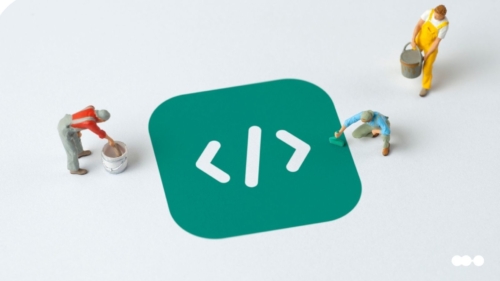
The shift to embrace systems of engagement (SOE) began a little over a decade ago, but critical areas of opportunity remain. That’s been due in large part to the effort and cost involved in customizing legacy stack components.
The emergence of low-code business process automation (BPA) is dissolving barriers to implementing systems of engagement. Low-code automation overlays the components of the existing stack to extend the capabilities of current systems and invites business teams into co-creative roles. This allows businesses to build more effective processes and workflows, as well as modify and automate them faster than ever before.
Below, we’ll parse out the differences between a system of engagement vs. a system of record, consider the value that an SOE adds to the existing stack, and look at how low-code BPA makes it possible to build an SOE layer over current systems.
The Definitive Guide to Business Process Automation

What is a system of engagement (SOE)?
Systems of engagement are the apps and software components that business users interact with in order to complete tasks and work activities. They are called “systems of engagement” because they are designed to invite input and collaboration, and give business users more agency to solve problems. Systems of engagement are designed to enable more meaningful and complex interactions.
Put another way, systems of engagement are software or apps that encourage user participation and communication. Systems of engagement are designed to maximize accessibility, participation, and usefulness.
Examples
- Collaboration tools
- Mobile apps
- Social media channels
- Low-code software
- Point solutions
Systems of engagement augment and complement the primary components of the tech stack such as the ERP, CRM, and databases. These elements make up an organization’s system of record.

What is a system of record (SOR)?
Systems of record are data management and storage systems that serve as a centralized, single source of truth for data and other information. Systems of record prioritize data integrity and control, so access to data is restricted and monitored. Systems of data may be stored on site or in the cloud.
Systems of record often contain data related to core business processes and therefore are important sources of information for strategy setting and decision making.
Examples
- ERP
- CRM
- MES
- HRIS
- Other primary stack components
Limitations
Systems of record are very good at centralizing and managing data, but they aren’t always easy to adapt to evolving business needs or process changes. In Geoffrey Moore’s 2011 paper which coined the phrase “system of engagement,” Moore argues for more business systems that can meet user expectations, as well as other types of technology.
He poses three critical questions:
- Why aren’t business-critical systems and processes as easy to implement as an app on a smartphone?
- How do businesses more effectively tap into their employees’ experience and knowledge?
- How much does legacy technology cost businesses in terms of productivity and efficiency when it cannot be adapted easily or quickly?
According to Moore, many businesses face the same dilemma: updating legacy systems is necessary to remain competitive — but these changes are complex and expensive. At the same time, business processes today depend on collaboration more than ever before. Most systems of record simply aren’t capable of accommodating this higher degree of collaboration. This is where a system of engagement comes into play.
System of record vs. system of engagement
Before we move on to why a system of engagement is important, here’s a quick summary of the differences between an SOR and an SOE:
| System of record (SOR) | System of Engagement (SOE) |
|---|---|
| Centralized | Decentralized |
| Authoritative resource | Collaborative resource |
| Ad-hoc, restricted access | Role-based access and user management |
| Users require training | Intuitive user interface |
| Emphasis on control | Emphasis on accessibility |
Why are systems of engagement important?
Systems of engagement play a crucial role in driving productivity and enhancing collaboration. They democratize problem-solving and build stronger cross-team relationships. When combined with low-code, a system of engagement delivers a host of benefits to the organization.
Cultivate collaboration
Processes and workflows are becoming increasingly complex. They depend on inputs and actions from both internal and external stakeholders. Processes often need to cross team, department, and system boundaries in order to achieve their goals.
Collaboration and communication are cornerstones of systems of engagement. This means capturing and consolidating information from forms, email, chat, as well as inviting input and increasing accessibility.
Strengthen the business team and IT relationship
Business users are often the subject matter experts for the processes and workflows they manage. They understand the sequence of events, the activities, and all the nuances that impact process effectiveness.
A system of engagement puts business users in a co-creative role with the IT team. Business users can help identify solutions to problems and — with low-code tools — implement changes on their own. This reserves IT resources for higher priorities while giving the business team more agency in their work.
Improve business agility
Systems of engagement can also help business users build and optimize processes more quickly. When low-code BPA is used as the system of engagement for systems of record, business teams can build, modify, and automate their processes and workflows more quickly.
This keeps businesses agile by allowing fast responses to:
- Competitor activity
- Customer feedback
- Market changes
- Internal requirements
Dissolve silos
Another way systems of engagement improve processes is by dissolving data silos. As SOEs are integrated with the components of the existing tech stack, data is more easily shared across users, apps, and systems.
Maximize stack extensibility
One of the most common challenges facing businesses today is figuring out how to get more from their existing apps and systems, without investing in complex and expensive customizations. A system of record built on low-code BPA provides an orchestration layer to fill in process gaps and help teams automate processes that aren’t easily automated with the existing components.
Learn more about stack extensibility.
Is it possible to integrate both an SOR and SOE?
Absolutely. In fact, most businesses need both systems of record and systems of engagement to meet their goals.
Geoffrey Moore wrote that a system of engagement should “overlay and complement our deep investments in systems of record.” That is exactly how low-code BPA works.

Low-code BPA combines an intuitive user interface, rules engine, and database to provide an overall orchestration layer for the existing tech stack. Users (with permission) can access and update work items and other information through multiple channels, and external users can be invited to collaborate through forms and portals.
Integrations connect the various apps and system components to create seamless user experiences and remove data silos. Low-code BPA also automates the workflows and processes that can’t be automated with the existing components.
Build better processes with BPA
Low-code business process automation augments your existing tech stack by filling in process gaps and providing an orchestration layer to coordinate workflows and processes throughout the organization. Process managers and users with permission are able to build, optimize, and automate their processes using an intuitive visual interface.
When processes are managed using BPA, they become more standardized. This makes it easier for IT teams to enforce security and compliance requirements, deepens visibility into process performance, and helps teams avoid costly and time-consuming customizations.






